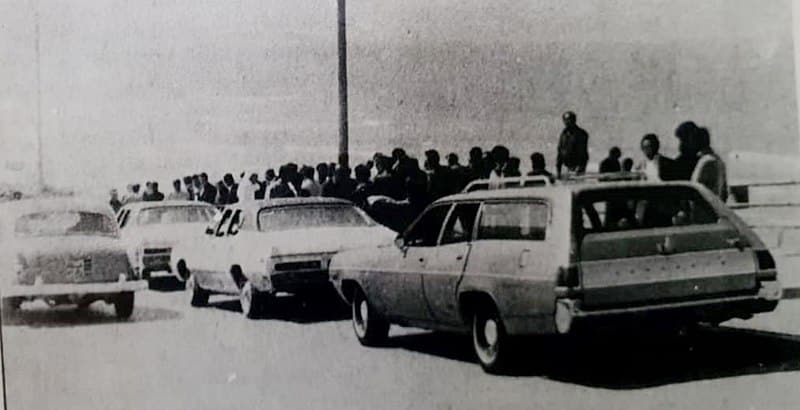49 years ago today, on the night of April 9 and 10 1973, the IDF set off on Operation Spring of Youth, in which it raided several targets associated with the Fatah Organization (the PLO) and the Popular Front for the Liberation of Palestine (PFLP) on Lebanese soil.
The operation was a success, having achieved its goals under difficult conditions. The operation destroyed terrorist command posts, killed 50–100 of them, including three senior leaders. Our forces lost two soldiers: Avida Schorr and Hagai Ma’ayan.
The background: from reactive to proactive
1972 was a bloody year. This was the year in which the massacre at Tel Aviv Airport took place (25 travelers were murdered and another 72 were injured); a bomb was discovered on an airplane that was en route from Rome to Israel; terrorists raided the Israeli embassy in Bangkok; hundreds of letter bombs were sent to Jews in Israel and around the world; and of course, that was the year of the brutal Munich Massacre of 11 athletes from the Israeli delegation to the Munich Olympics.
This wave of terror outrages, topped by the athletes’ massacre in Munich, brought about a change in the Israeli policy: instead of reactive measures, a policy of proactivity. Since the terrorist organizations began converging in Lebanon in general and Beirut in particular, this was chosen as the target where the IDF would attack the terrorists proactively.

Operation Order: Five Targets
The Operation Order listed five targets:
1. Aviva – the operation’s main target: two seven-story buildings in which three of the to Fatah leaders had taken up residence.
2. Gila – a seven-story building in which, according to intelligence, the Popular Front for the Liberation of Palestine personnel had occupied all floors.
3. Zilla – a workshop in which landmine parts were being made.
4. Varda – two buildings, one of which was a rocket-building and marine mines workshop and the second served as the Gaza Strip headquarters.
5. Yehudit – a garage, which was used as a workshop in which weapons and ammunition repair work was done.
The Execution
The Israeli forces landed simultaneously on several Lebanese beaches, transported there on board missile boats. They made landfall in rubber dinghies assisted by Shayetet 13 commandos. On shore they were received by Mossad operatives driving cars they had rented the day before.
18 Sayeret Matkal commandos arrived by car at the Aviva target, which was the main target, driving to a spot close to the building. From there they continued on foot, some disguised as women and escorted by commandos clad in men’s clothes. Ehud Barak (disguised as a brunette) walked hand in hand with Muki Betzer, Dov Bar with Amiram Levine (disguised as a woman in a chestnut wig), and Yoni Netanyahu was also among the commandos. This way they managed to reach close to their destination without arousing suspicion.
The Gila target, which was the most heavily defended due to the many armed terrorists living there, cost the lives of two commandos: Avida Schorr and Hagai Ma’ayan.
At the rest of the targets also, the operation’s goals were achieved, and the bottom line was that targets were destroyed which had been used for manufacturing and repairing weapons, the Democratic Front for the Liberation of Palestine building was destroyed with dozens of their fighters buried under the rubble, and three top Fatah and Black September leaders were killed.
Clip from the feature film Munich, showing the early stages of the raid on the Aviva target.
The Background: The Power of Precision Intelligence
“I haven’t been on any operation with intelligence of this quality, providing even the finest details so expansively“ Gen. (Res.) Ehud Barak, Commander of Sayeret Matkal during the operation
To achieve such a high level of success behind enemy lines, one needs brilliant, pinpoint-precision planning in advance. And indeed, the intelligence obtained for Operation Spring of Youth was some of the most precise in IDF history thanks in part to Yael Mann, a Mossad operative who worked in Lebanon, photographed the areas where the targets to be liquidated were living and collected information about them. Sigint unit 848 also took part in the operation, continuously eavesdropping on the Lebanese communication networks. These intelligence outputs included precise diagrams of the targets, maps of the defensive positions and precision information as to the whereabouts of the senior terrorists. Almost all the operation commanders have spoken on various occasions along the lines of Ehud Barak’s above comment: they had never been given such precise intelligence.
Of course intelligence was not the only contributor to the success – planning and training was also part of it. Raffi Eyal, one of the commandos at the Gila target, tells: “The preparation for the rest of the parts of the operation was very thorough. We underwent training on guerilla warfare, using gas, firing with silencers, and maneuvering in civilian clothing. Most of the training took place in urban areas such as Ramat Aviv. We would do landing practice from the sea and then continue to advance into the city just as if it was Beirut“.
The Chief of Staff Citation was awarded to Ehud Barak, in part in recognition of his conduct during Operation Spring of Youth.
